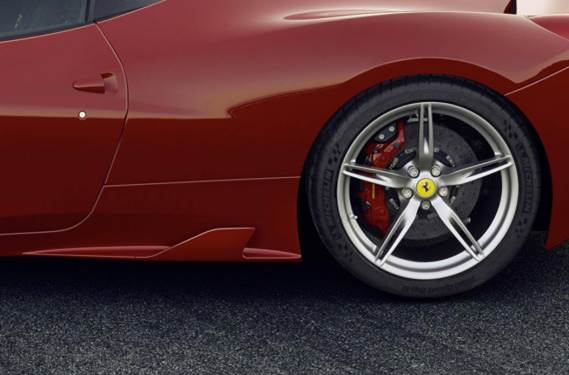For all the Speciale’s changes, it’s still the 458′s super-quick steering that requires most acclimatization –it’s fighter-jet agility remains shocking and it takes a few corners to realise that, yes, you really can keep your hands fixed in place on the steering wheel, even though tight hairpins. There’s more steering feel traveling up the Speciale’s rack now than we’ve grown accustomed to in the latest Ferraris, though, and that significantly increases the sense of interaction.
We spend the next couple of hours darting back and forth on that epic road, noticing the brakes’ refusal to fall into ABS intervention if you approach hairpins just a bit too quickly, the lack of body-roll, and those witchcraft downshifts, Ferrari saying that the delay between a paddleshift command and the resulting downshift is now reduced by 44 per cent: you’ll feel the difference as a more positive transition between revs. But what you feel more than anything is total and utter connection to the car, a level of transparency that positively encourages you to push the Speciale beyond sane links like a few pints might convince you to take to the dance floor – only this time you’re not delusional.

The Italia’s boundary line that combines ‘you are now leaving grip’ and ‘welcome to understeer’ in one clearly legible signpost remains intact, but stickier Michelin Pilot Sport Cup 2s mean it’s shifted significantly to the north and feels even more precisely defined, allowing you to carve into corners with more speed and confidence than before.
So you balance on that tightrope and feed in the lock and you might just sense the E-diff beginning to lock. It gives the rear end a feeling of taut controllability and up-for-it eagerness, and if you’re feeling brave you’ll squirt the throttle and the rear end will slide out quickly, the revs will shout ‘boo!’ and your eyeballs will pop out of their sockets as if they’re spring-loaded on comedy glasses.
Don’t be too spooked: as with all modern Ferraris, there’s a manettino – a.k.a. little dial – on the steering wheel that allows you to switch between modes for the gearbox, ABS, suspension, E-diff and, crucially, stability control systems. Only this time the stability control is also aided and abetted by Side Slip angle Control (SSC), a very advanced bit of gadgetry that promises to operate subtly in the background while you push the Speciale to the limits of adhesion and beyond, but will still intervene to prevent slides from becoming too extreme.

It’s active in the Race and CT Off (traction control) manettino modes and it’s pretty bloody clever, but at lower speeds on the road where angles are more likely to be greater – hairpins, for instance – there’s still an unmistakable sense of something pulling you back from the precipice even when you’ve got everything under control; you still need to turn everything off to have fun. In fact, SSC saves its real genius for the faster corners of the racetrack, a place where 47 per cent of buyers are predicted to go, versus 16 per cent of Italia owners.
On track at Fiorano you’re simply aware of the Speciale feeling incredibly planted as well as having an extremely positive front end and an overall balance that initially feels psychotic, so keen is the car to oversteer. And yet it’s actually very easy and incredibly satisfying to hold just beyond the limit, even at very high speed. The problem on track is trying to stop the slides becoming too ridiculous and sapping time. That’s where Side Slip angle Control comes in. Switch the manettino to CT Off to activate SSC and you’re flattered into thinking you’re driving very neatly, neatly, with just the perfect serving of slip to point you through the corner. Yet the electronics are working constantly, a furious whirling of swan’s feet below the surface that belies your effortless progress. Only occasionally do you feel SSC’s intervention because, unlike larking about on hairpins, you’re not really trying to generate much slip in the first place. But then you turn everything off and the slides get much, much wilder. While a good driver could easily catch those slides, I think it’d take an exceptional one to hold them at the perfectly judged angles that SSC does.

As the sun goes down it’s time to reluctantly hand back the keys and head to the customary, slightly intimidating one-on-one debrief with Ferrari CEO Amedeo Felisa. I try to get my thoughts straight on my way to his office.
There’s no doubt that the Speciale is the better car to drive on track and when you’re at ten-tenths on the road; for its intended customer base that’s absolutely right. But potential buyers need to think carefully because the Italia continues to make a strong case for itself – it’s still a scintillating car, one with performance to send shivers down your spine and a chassis that’ll have you hooting out loud. The Italia comes far closer to the Speciale in terms of all-out driver satisfaction, for instance, than a 911 Carrera does to a GT3, and yet it’s also a notably more rounded proposition.
If you’re lucky enough to have several cars and you just want the purest expression of a 458 for weekend drives and track sessions, you won’t go wrong with a Speciale. However, if you’re actually going to cover a few miles in your 458 and won’t be welding the accelerator to the floor-mat all the time, I’d have no hesitation in sticking with an Italia.
‘Hello, Ben Barry? Yes, Mr. Felisa will see you now….’
Specs Price: $344,758 Engine: 4497cc 32v V8, 605 PS @ 9000rpm, 540 Nm @ 6000rpm Transmission: Seven-speed dual-clutch gearbox, rear-wheel drive Performance: 3.0sec 0-100m/h, 327+km/h, 8.5 km/l, 275g/km (with optional HELE stop/start) Suspension: Double wishbones front, multi-link rear Weight: 1395kg |